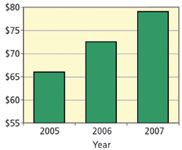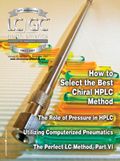Clinical Flow Cytometers
Many analytical instruments traditionally used for research and development purposes are making a significant move into the clinical diagnostic market. One such technique is flow cytometry, a method used to examine the physical and chemical properties of cells.
Clinical Flow Cytometers
Many analytical instruments traditionally used for research and development purposes are making a significant move into the clinical diagnostic market. One such technique is flow cytometry, a method used to examine the physical and chemical properties of cells. Flow cytometry combines several disciplines to elucidate information like size, shape, and surface receptors of cells. This instrumentation involves multi-wavelength lasers, sophisticated optics arrangements and a several different detector types.

North American clinical flow cytometry market.
Flow cytometry instrumentation offers clinicians several advantages over conventional cytometry methods like light and fluorescence microscopy and bulk biochemical assays. It offers speed and complete automation from sample preparation to collection. Applications involving HIV research and the need to monitor illnesses like leukemia have created a niche market for flow cytometry. Common applications for these instruments include counting and monitoring specific cell types in a patient's bloodstream to HIV or analyzing the level of white blood cells in cancer patients. These instruments provide physicians with more information in less time, allowing them to provide patients with better and immediate treatment.
The market for clinical flow cytometry accounts for a significant portion of the overall flow cytometry market. Increasing government expenditures for healthcare, in particular, for HIV and cancer has a strong influence in this segment. In addition, the increasing consumption of reagents for routine tests is driving growth in the aftermarket segment. In 2006, the North American clinical flow cytometers market accounted for almost $73 million.
The foregoing data was extracted and adapted from SDi's Global Assessment Report, 9th Edition. For more information, contact Glenn Cudiamat, VP of Research Services, Strategic Directions International, Inc., 6242 Westchester Parkway, Suite 100, Los Angeles, CA 90045, (310) 641-4982, fax: (310) 641-8851, e-mail: cudiamat@strategic-directions.com
Regulatory Deadlines and Supply Chain Challenges Take Center Stage in Nitrosamine Discussion
April 10th 2025During an LCGC International peer exchange, Aloka Srinivasan, Mayank Bhanti, and Amber Burch discussed the regulatory deadlines and supply chain challenges that come with nitrosamine analysis.
Top Execs from Agilent, Waters, and Bruker Take the Stage at J.P. Morgan Healthcare Conference
January 16th 2025The 43rd Annual Healthcare J.P. Morgan Healthcare Conference kicked off in San Francisco earlier this week. Here’s what top executives from Agilent, Bruker, and Waters, discussed during the event.

.png&w=3840&q=75)

.png&w=3840&q=75)



.png&w=3840&q=75)



.png&w=3840&q=75)





